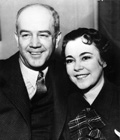|
|
NC13315: Western Air Express Flight 7 Crashes in Newhall
Accident Board of the Bureau of Air Commerce
May 12, 1937
|
Webmaster's note: The investigation into the crash of Western Air Express Flight 7 in the mountains south of Newhall on Jan. 12, 1937, was conducted by the Accident Board of the Bureau of Air Commerce, the predecessor to the NTSB. This copy of the investigation report comes from the Aircraft Crashes Record Office/Bureau d'Archives des Accidents Aéronautiques, a private database maintained in Switzerland. We don't know who made the spelling errors, but we haven't changed them. It may have been translated into French and then to British English. According to the U.S. Department of Transportation, the official report (which has no docket number) was adopted May 12, 1937.
Date & Time: 12 JAN 1937 at 1107 Local Time Circumstances While overflying Saugus at 5,200 feet, aircraft was already 300 feet to low. Pilot tried to contact ATC without any success. Due to low visibility caused by fog, pilot did not realise he was flying at an unsufficient altitude. In a descent rate of 525 feet per minute, aircraft hit Pinetos Peak. The copilot and four passengers, among them the explorer Martin Johnson, were killed. Causes Summarizing, therefore, it is evident that several factors gave rise to this accident. Advance notification to the control tower at Burbank, either by the pilot or company personnel, would have assured continuous localizer operation, available to the pilot when needed. Continuing down the Saugus range for two minutes before switching to the Burbank localizer, as prescribed by the company, would have kept the pilot on course for at least two minutes longer and the danger of colliding with the mountains would have been reduced by that much. However, the Saugus range was in continuous operation and it is not understood why the pilot did not immediately switch back to this range when he discovered that the Burbank frequency was busy with voice transmission. This would have definitely guided him through the high mountains or until he had requested and received continuous operation of the Burbank range. Likewise, it is not understood why the pilot continued in descending flight without the aid of range guidance. It is the opinion of the Accident Board that the probable cause of this accident was error on the part of the pilot for descending to a dangerously low altitude without positive knowledge of his position.
|
News Reports
Moving the Injured
Victim Transported
Osa Johnson Rescued
Martin Johnson's Body
Victim Recovery
Body Removal
Same Plane 1933
Martin Johnson
|
The site owner makes no assertions as to ownership of any original copyrights to digitized images. However, these images are intended for Personal or Research use only. Any other kind of use, including but not limited to commercial or scholarly publication in any medium or format, public exhibition, or use online or in a web site, may be subject to additional restrictions including but not limited to the copyrights held by parties other than the site owner. USERS ARE SOLELY RESPONSIBLE for determining the existence of such rights and for obtaining any permissions and/or paying associated fees necessary for the proposed use.










